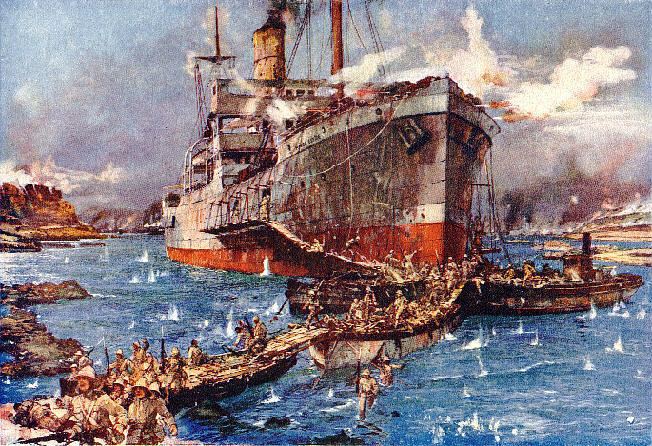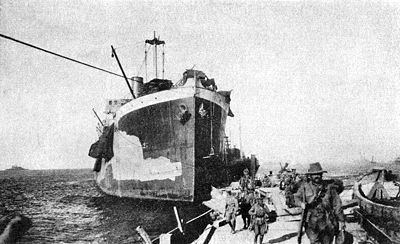Yard number 537 Out of service 1915 Length 105 m | Namesake River Clyde, Scotland Completed March 1905 Launched 1905 Draft 5.46 m | |
 | ||
Owner River Clyde Steam Ship Co Ltd (Ormond, Cook & Co), Glasgow | ||
SS River Clyde was a 3,913 GRT British collier built by Russell & Co of Port Glasgow on the Firth of Clyde and completed in March 1905. In the First World War the Admiralty requisitioned her for the Royal Navy and in 1915 she took part in the Gallipoli landings. After the war she was repaired and sold to Spanish owners, with whom she spent a long civilian career trading in the Mediterranean before being scrapped in 1966.
Contents

Propulsion

River Clyde had nine corrugated furnaces with a combined grate area of 169 square feet (16 m2) that heated three 180 lbf/in2 single-ended boilers with a combined heating surface of 6,150 square feet (571 m2) to raise steam for her three-cylinder triple expansion engine. The engine was built by J.G. Kincaid & Co of Greenock and was rated at 374 NHP.
Gallipoli

Early in 1915 River Clyde was adapted to be a landing ship for the joint French and British invasion of the Gallipoli Peninsula.

Openings were cut in her steel hull as sally ports from which troops would emerge onto gangways and then to a bridge of smaller boats from the ship to the beach. Boiler plate and sandbags were mounted on her bow, and behind them a battery of 11 machine guns was installed. The machine gun battery was manned by Royal Naval Air Service men commanded by Josiah Wedgwood. Work began on painting River Clyde's hull sandy yellow as camouflage, but this was incomplete by the time of the landing.
By 11 April 1915 River Clyde was in the natural harbour of Moudros on the Aegean island of Lemnos, where French and British ships were assembling in final preparation for the landings. The troop ship HMT Aragon reached Moudros from the Port of Alexandria in Egypt and transferred the 4th Battalion, the Worcestershire Regiment and the 2nd Battalion, the Hampshire Regiment to River Clyde. Both Battalions were units of the 88th Brigade, which was part of the 29th Division.
On 25 April 1915 River Clyde sailed to take part in the landing at Cape Helles. She was commanded by Commander Edward Unwin, formerly of the Dryad-class torpedo gunboat HMS Hussar. She was carrying 2,000 soldiers; mostly from 86th Brigade units of the 29th Division: the 1st Battalion of the Royal Munster Fusiliers and men from the 1st Battalion, the Royal Dublin Fusiliers.
Unwin beached River Clyde at V Beach beneath the Sedd el Bahr castle, on the tip of the Gallipoli peninsula. The plan failed and the River Clyde, beached under the guns of the Turkish defenders, became a death trap. Three attempts to land made by companies of Munsters, Royal Dublins and Hampshires all ended in costly failure. Further landing attempts were abandoned and the surviving soldiers waited until nightfall before trying again.
Members of River Clyde's crew maintained the bridge from the ship to the beach and recovered the wounded. For their bravery six of them were decorated with Victoria Crosses: Commander Unwin (aged 51), Midshipmen George Drewry (20) and Wilfred Malleson (18), Able Seaman William Williams (34) and Seaman George Samson (26), plus Sub-Lieutenant Arthur Tisdall (24) of the Royal Naval Division (RND). Williams was killed in the landing and was decorated posthumously. Samson was severely wounded the next day but survived. On his return to Scotland he was handed a white feather while wearing civilian clothes. Tisdall was killed on 6 May when the 6th (Hood) Battalion RND advanced along Kanlı Dere in the Second Battle of Krithia. Drewry, Samson and Williams had come with Unwin from HMS Hussar. Malleson, who died in 1975, served on the Duncan-class battleship HMS Cornwallis.
After the Helles beach-head was established, V Beach became the base for the French contingent and the River Clyde remained beached as a quay and breakwater. Her condensers provided fresh water and her holds became a field dressing station. She remained a constant target for Turkish gunners ashore.
Return to civilian service
In 1919, River Clyde was refloated by the Ocean Salvage Co. and taken to Malta. The British Government refused a proposal to purchase her to return to the UK for mooring in the River Thames as a monument to the landings because of the cost. Consequently she was repaired at Malta and sold to civilian Spanish owners. She operated as a tramp steamer in the Mediterranean, first as Angela and then Maruja y Aurora. Maruja and Aurora were the names of the eldest child of each of the two partners in the company, Gumersindo Junquera Blanco and Vicente Figaredo Herrero.
She was seized by Spanish Nationalist forces at Santander in August 1937 and used by the Nationalist navy, during which time she captures the steamship Margarita. She made trips between Santander and Ferrol, and carried troops between Gijon and Bilbao. Returned to her former owners 18 months later, she resumed her previous commercial role, and she rescued three British airmen during World War II.
In 1965 there was an attempt to buy and preserve River Clyde but the British Government were unwilling to purchase her, and in 1966 she was sold for £42,000 for scrap and broken up at Avilés, Spain.
